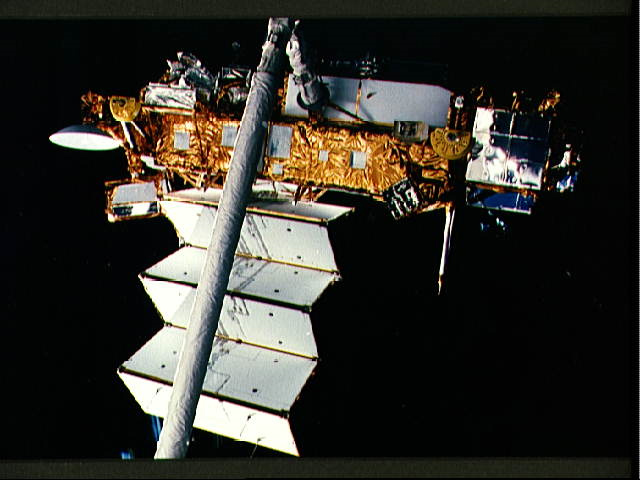Falling Satellite Poses Little Risk to Public, NASA Says

For the latest news about NASA's UARS spacecraft fall, visit: Falling NASA Satellite: Complete Coverage of UARS Spacecraft's Fiery Demise.
An outdated NASA satellite, which has been adrift in orbit for six years, is falling back to Earth, and some of its debris is expected to reach the ground in the next few weeks. But despite the chance that bits of debris could land in North or South America, the space agency is assuring the public that there is no reason to be alarmed.
"Satellites re-entering is actually very commonplace," Nick Johnson, chief scientist of the Orbital Debris Program at NASA's Johnson Space Center in Houston, said at a news briefing today (Sept. 9). "Last year, for example, we averaged over one object per day falling back uncontrolled into the atmosphere." [Photos: Space Debris & Cleanup Concepts]
NASA's Upper Atmosphere Research Satellite (UARS), a school bus-size spacecraft, will re-enter Earth's atmosphere sometime in late September or early October, agency officials said. Debris from the satellite could fall over a swath of land stretching more than 500 miles (804 kilometers) anywhere between northern Canada and southern South America.
Narrowing down the area of impact will not be possible until much closer to when the pieces will hit, said Air Force Maj. Michael Duncan, deputy chief of the U.S. Strategic Command's space situational awareness division.
Johnson stressed that these incidents are not so rare. In 2010 alone, some 400 pieces of space debris were cataloged by the U.S. Space Surveillance Network, he said. [Infographic: NASA's Falling UARS Satellite Explained]
On average, one moderate-size object, which could be an old, intact spacecraft or rocket body, falls to Earth every week. The majority of the debris disintegrates upon re-entry into Earth's atmosphere, but some of the vehicle components do reach the surface, Johnson said. These pieces of space junk typically fall over broad ocean areas or desolate regions like the Australian outback or the Canadian tundra.
Breaking space news, the latest updates on rocket launches, skywatching events and more!
Regarding larger objects such as the nearly 12,500-pound (5,668 kilograms) UARS, the U.S. Space Surveillance Network typically sees one of these re-entering the atmosphere per year.
The spacecraft is about 35 feet (10.7 meters) long and 15 feet (4.5 m) wide. And while agency officials said UARS is the largest NASA satellite to make an uncontrolled fall back to Earth in years, Johnson clarified that re-entry events of this size are "certainly not unknown or unprecedented." [Related: Space Junk FAQ: Falling Space Debris Explained]
"Last year there were 75 metric tons of spacecraft and rocket bodies falling back to Earth in an uncontrolled manner," Johnson explained. "In perspective, UARS is less than 6 metric tons, so it's a very small percentage of the annual re-entry of satellites into Earth's atmosphere."
Even when pieces of defunct satellites and rocket bodies do reach the ground, the chances of them posing a risk to people and their property is very remote, NASA said.
NASA officials estimate that there is a 1-in-3,200 chance that a person somewhere on Earth will be hit by UARS debris, and the odds of the dead satellite re-entering over a densely populated area is very small. [Video: The Expanding Danger of Space Debris]
NASA and the U.S. Space Surveillance Network has closely studied the satellite to determine the potential risks during its re-entry. Current projections show that 26 large pieces, totaling approximately 1,170 pounds (532 kg), will survive the trip through Earth's atmosphere.
Still, the chances of the UARS satellite causing any real harm is very small, officials said.
"Throughout the entire 54 years of the Space Age there has been no report of anyone being injured or impacted by any re-entering debris," Johnson said.
You can follow SPACE.com staff writer Denise Chow on Twitter @denisechow. Follow SPACE.com for the latest in space science and exploration news on Twitter @Spacedotcom and on Facebook.
Join our Space Forums to keep talking space on the latest missions, night sky and more! And if you have a news tip, correction or comment, let us know at: community@space.com.

Denise Chow is a former Space.com staff writer who then worked as assistant managing editor at Live Science before moving to NBC News as a science reporter, where she focuses on general science and climate change. She spent two years with Space.com, writing about rocket launches and covering NASA's final three space shuttle missions, before joining the Live Science team in 2013. A Canadian transplant, Denise has a bachelor's degree from the University of Toronto, and a master's degree in journalism from New York University. At NBC News, Denise covers general science and climate change.
